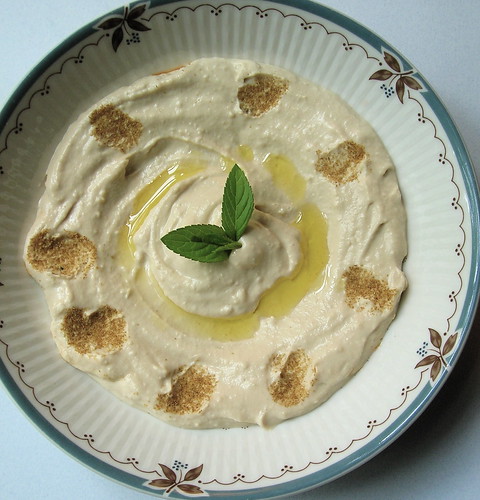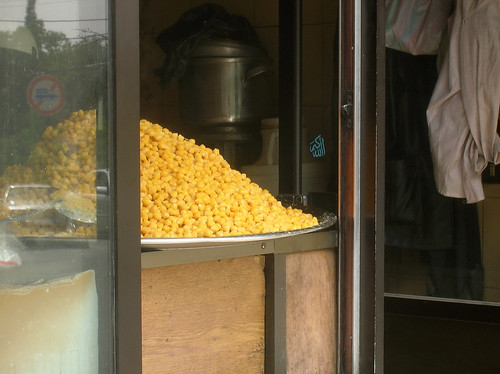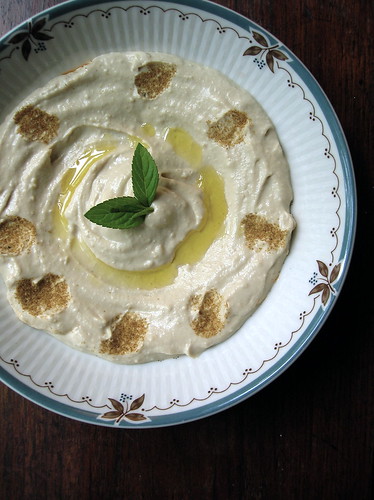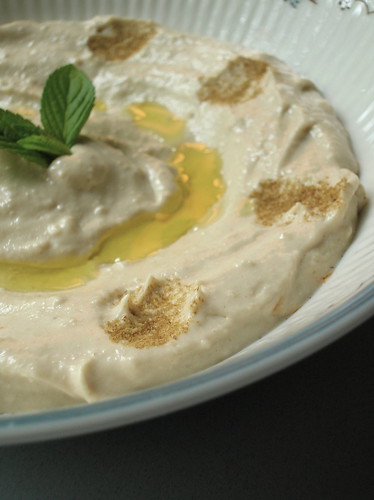
In general, I am fairly open to different interpretations of dishes, I am not one of those pedants who will tell you couscous must absolutely be made in a special clay pot, or pasta has to be made with just that flour. However, having lived in the Middle East, there are some offenses committed against Middle Eastern/Arab foods that really get under my skin. To name two basic staples: hummus and tabboule. My irritation stems less from the misappropriation of these dishes, but rather that these dishes are so good when properly made that people have no idea what they are missing.
Let's start with that ubiquitous staple: hummus, or it's full name hummus bi tahine. But first let me reveal something: few people living in Middle Eastern cities make their own hummus. They buy it, from hummus vendors, often called hamsani. Just like the French purchase their croissants and Italians buy much of their pasta, Levantine cities have hummus shops on every corner. These shops sell freshly cooked chickpeas, hummus, and dried fava beans called foul. There's usually a few little tables or a counter to eat a bowl of hummus and a takeout counter where hummus is sold by weight in plastic bags. Now, let's get to some of the qualities of good hummus:

One of the important attributes of hummus is that it is a smooth consistency, which is where many attempts at hummus fail. The traditional tool for this is a food mill, but a food processor or blender can work equally well. Another key to the smoothness of your hummus is the chickpeas themselves: the chickpeas should be cooked so that they are meltingly soft and the outer skins have fallen away. In fact,, I really find that the best, smoothest hummus comes when you peel the chickpeas. And yes, this sounds crazy, but it really doesn't take much time (you just sort of pinch them and they pop off) and it makes a vast improvement in the texture of your hummus.
Secondly, the word hummus means 'chickpea.' You are free to mix many things into your hummus, but the base ingredient should remain chickpeas. Not white beans, not red peppers, not olives nor beets. It's totally fine if you use these things, but please use a name other than hummus. There are lots of good variations on hummus that I've listed below.
I've always said one of the keys to Arab cooking is the copious use of lemon juice in everything, and that holds true for hummus. Fresh lemon juice is best. Also, garlic and spices shouldn’t overwhelm, but this can vary on personal taste.
Finally, there is the issue of presentation. This also ties in to the above issue of consistency- your hummus should not be chunky or thick enough to make a mound (see: yes, yes, and no, no). You don't have to be perfect here, but choose a wide flat bowl or plate to serve your hummus. A drizzle of olive oil in the center is traditional, and you can also decorate with spices or chopped herbs.
I realize that this makes me sound like a total hummus dictator; I like to think of it as more of a hummus dilettante. But here’s what I’m saying: with all the rhetoric going around about a better understanding of the Middle East, let’s at least get the hummus right. After all, it’s a dish that’s been perfected over thousands of years, so get to know the classic version. I also realize a lot of people out there have already had these revelations, perhaps at their local Lebanese restaurant, or in their own kitchens and if you have any of your own tips or experiences, please feel free to share them in the comments.


Hummus bi Tahine
Although hummus is best made with freshly-cooked chickpeas, sometimes time and convenience mean that canned chickpeas are an acceptable option. Please also note the directions for making hummus in a food mill at the bottom. Don't be alarmed by the length of this recipe, I'm merely verbose, it's really quite simple.
3 cups cooked chickpeas, from 1 1/2 cups dried chickpeas, or 2 (15 oz) cans
1/2 tsp salt
1 garlic clove
1/2 cup tahini (sesame seed paste)
1/3 cup lemon juice
olive oil, parsley, paprika or cumin for serving
1. For dried chickpeas: Soak the chickpeas overnight in water. Drain, and place chickpeas in a pot and add fresh water to cover by at least one inch, gently rub the chickpeas against each other with your hands. Bring the chickpeas to a boil with a pinch of salt, skim the surface, then lower the heat and simmer until the chickpeas are tender, about 1 1/2 hours. If you are peeling the chickpeas, allow them to cool slightly and then peel them, pinching off the skins. Do not discard the cooking water.
For canned chickpeas: Rinse the chickpeas, then place in a saucepan with water to cover by one inch. Put your hands in the pot and gently rub the chickpeas against each other. Place saucepan on the stove and bring to a boil and simmer until chickpeas are very soft: test a chickpea by squeezing it between your fingers, it should smush easily, this could take between 5 and 20 minutes. Remove from the heat, skim off any chickpea skins that have floated to the surface and discard them. If you are peeling the chickpeas, allow them to cool slightly and then peel them, pinching off the skins.
2. Place the garlic and salt in a food processor and pulse to chop. Add the tahini and lemon juice and process until the mixture is slightly whitened and contracted. Use a slotted spoon to transfer the chickpeas to the processor (don't discard the cooking liquid) and process until very smooth. Thin the hummus to the desired consistency with the reserved cooking liquid. Taste and adjust seasoning with lemon juice and salt.
4. Make ahead: if you are making your hummus ahead of time, or don't plan to serve it immediately, the hummus will thicken up and stiffen as it sits. I recommend leaving the hummus in the bowl of the food processor until you are going to serve it (refrigerating overnight if necessary), and reserving some of the chickpea cooking liquid. Then, when you're ready to serve the hummus, simply process the hummus with a bit more cooking liquid to achieve the desired consistency. On the up-side, if you accidentally made your hummus too thin the begin with, then pop it into the fridge to thicken up a bit.
5. To serve: spread hummus in a shallow bowl, drizzle with olive oil and sprinkle with spices if desired. Traditional accompaniments include pita bread, pickles, fresh mint, and hot tea.
Variations:
- Hummus with Meat: In a pan, sauté some ground beef in a pan with a pinch of allspice and cinnamon until well browned, about 5 minutes. Crumble into small bits and scatter the meat over the hummus. You can also add diced onion and pinenuts to the meat mixture.
- Hummus Beiruti: Stir a large handful of chopped parsley into the hummus before serving.
- Hummus Musabahha: This version of hummus leaves the chickpeas somewhat chunky.
- Hummus bi Zeit (Hummus with oil): replace the tahine with olive oil. Please note that hummus is rarely made with both oil and tahini in the puree, it's either hummus with tahini, or hummus with oil, though olive oil is drizzled on top of both for serving.
- Warmed Hummus: Spread hummus in a shallow baking dish and bake until warmed through.
- Hummus bel Snoobar (Hummus with Pine Nuts): Sauté pine nuts in a generous spoonful of clarified butter. Pour the butter and toasted pine nuts over the surface of the hummus.
- Hummus Akhdar: Add in roasted red peppers and pomegranate molasses for a beautiful sour-sweet hummus.
- Hummus bi Sujuk: Sujuk is a traditional (and delicious!) Lebanese-Armenian beef sausage. Serve hummus topped with sauteed sujuk, or other sausage of choice.
*Also Note: I give instructions for using a food processor here, because I find it is most convenient in the modern kitchen, but the traditional way is to use a food mill: purée the chickpeas in a food mill. In a mortar and pestle smash together the garlic, salt, and lemon. In a large bowl, stir the garlic-lemon mixture into the tahini so that it lightens in olor and contracts slightly. Add the chickpea purée to the tahine mixture, adjust seasonings. Pass through a food mill one final time to combine. This traditional way produces the best, smoothest hummus in my opinion.






206 comments:
«Oldest ‹Older 201 – 206 of 206Har din हारते हुए लगा था कि ये गेम बेकार है। लेकिन आज पहली बार जितने का जो satisfaction है ना – वो priceless है! अब सच में कह सकता हूं sattaking aaj bnege sattaking se krorpati!
Doston, agar aap regular player हो, तो aaj ka din aap miss mat karo! Shayad आपकी bhi baji lag jaaye. Aur phir आप भी kehoge – “sattaking aaj bnege sattaking se krorpati.”
पहले लगा tha fake hai, par jab khud jeeta, tab yakeen aaya... Sattaking aaj bnege sattaking se krorpati sach hota hai!
Insta Connect
Neon Quest Interactive provides Mobile App Development Services Dubai, creating innovative, user-friendly apps for iOS and Android. Our expert developers use cutting-edge technologies to deliver seamless, high-performance applications tailored to your brand. We focus on engaging user experiences that drive interaction and loyalty, ensuring your business excels in Dubai’s competitive mobile market.
Post a Comment